Maakt de gedachte aan reizen met SIBO u bang? Ben je bang dat je nooit meer het huis uit zult kunnen?
Het goede nieuws is dat het hebben van SIBO niet betekent dat je een kluizenaar hoeft te zijn. Ik ben een fervent reiziger en heb sinds mijn SIBO-diagnose veel landen bezocht. En ik ben hier om je te vertellen dat het mogelijk is om met SIBO te reizen.
In de afgelopen maand ben ik twee keer van en naar de VS gereisd. Dat zijn 4 langeafstandsvluchten plus kortere binnenlandse vluchten. Ik heb de mijne en de beste tips van de Healthy Gut-gemeenschap voor je verzameld over hoe je internationaal kunt vliegen met SIBO.
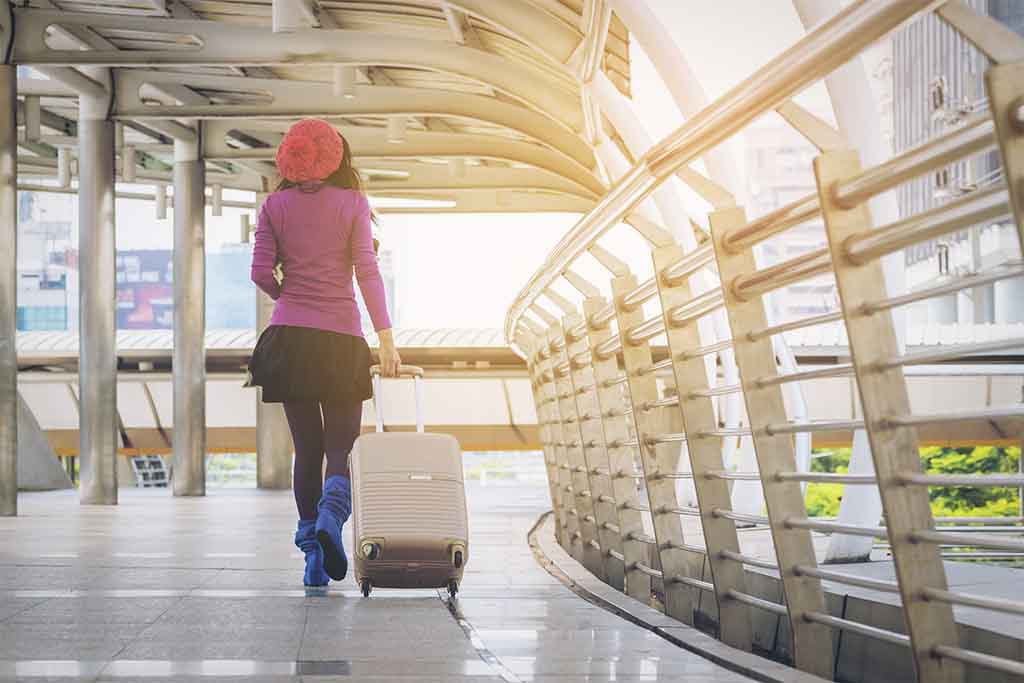
Als je gaat investeren in een internationale reis, beknibbel dan niet op de vlucht. De ervaring die je hebt met een luchtvaartmaatschappij kan het begin en einde van je reis fantastisch of verschrikkelijk maken. U wilt genieten van uw vlucht en de luchtvaartmaatschappij die u kiest, kan een grote rol spelen om dat mogelijk te maken.
Bedenk wat belangrijk voor je is:

De snelheid waarmee u uw bestemming kunt bereiken



































Het aantal verbindingen dat u moet maken of een rechtstreekse non-stop vlucht



































Voorzieningen tijdens de vlucht



































Maaltijdopties



































Stoelafstand en -breedte



































Upgrade-opties
Als ik langer dan een paar uur op reis ben, zet ik mijn comfort altijd op de eerste plaats. Ik kies luchtvaartmaatschappijen die upgrades naar een meer premium cabine toestaan en een goede service aan boord bieden. Ik vlieg Virgin Australia van en naar de VS omdat u een bod kunt uitbrengen op de Premium Economy en Business hutten. Ik koop een Economy-stoel en bied vervolgens het laagst mogelijke bedrag voor een upgrade. Als ik het niet krijg, heb ik niets betaald, dus het is een geweldige optie. Ik heb slechts één keer een upgrade gemist en heb het geluk gehad om op verschillende reizen een upgrade naar Business te krijgen.
Ik heb ook met Air New Zealand gevlogen naar de VS op verschillende reizen, en hun Premium Economy- en Business-cabines zijn fantastisch, plus hun service is uitstekend, hoewel ze niet de biedoptie bieden zoals Virgin Australia dat doet, maar vaak geweldige verkopen hebben, zodat u een tarief kunt ophalen voor een goede prijs.
Natuurlijk, als je het je kunt veroorloven om een premium stoel te kopen, doe dat dan! Het maakt vliegen zoveel leuker.
Ik heb in het verleden met goedkopere luchtvaartmaatschappijen internationaal gevlogen, maar ben uitgeput aangekomen nadat ik urenlang als een sardine volgepropt was, en werd zelfs seksueel misbruikt op een vlucht met Royal Brunei Airlines (Londen naar Melbourne), waar het personeel en de luchtvaartmaatschappij er niets aan deden . Ik had die vlucht gekocht omdat hij zo goedkoop was; het leek te mooi om waar te zijn. Het was en ik ga nooit meer voor de goedkoopste luchtvaartmaatschappij.
"Reizen is een geweldige ervaring. Laat SIBO je er niet van weerhouden de dingen te doen waar je van houdt."
Rebecca Coomes
Ik vlieg altijd met luchtvaartmaatschappijen op langeafstandsvluchten waarmee ik mijn stoel van tevoren kan selecteren. Als je SIBO hebt, heb je genoeg angst om naar het toilet te gaan. U hoeft zich geen zorgen te maken dat u geen comfortabele stoel heeft.
Op langeafstandsvluchten, ik altijd kies een stoel aan het gangpad, zodat ik gemakkelijk naar het toilet kan en niet over vreemden hoef te klimmen of iemand lastig te vallen door mijn constante toiletbezoek.
Als u een nachtvlucht maakt, wilt u misschien een stoel bij het raam, zodat u tegen het vliegtuig kunt rusten terwijl u slaapt. Persoonlijk word ik te angstig bij de gedachte dat ik niet naar het toilet kan, dus ik zal altijd de voorkeur geven aan een stoel aan het gangpad boven een stoel bij het raam.
Wilt u zien wat de beste stoelen zijn op uw vlucht? Bekijk Seat Guru waar u uw luchtvaartmaatschappij en vluchtnummer kunt invoeren, en zij zullen u laten zien wat de beste en slechtste stoelen in het vliegtuig zijn.
Net zoals uw stoelkeuze belangrijk is om uw toiletangst tijdens de vlucht te verminderen, is het ook belangrijk om te kiezen om te vliegen met een luchtvaartmaatschappij die een breed scala aan maaltijden aan boord aanbiedt.
Scroll naar beneden om mijn gedachten over eten in een vliegtuig te zien, maar ik denk dat het belangrijk is om een maaltijd tot je beschikking te hebben, zelfs als je die niet opeet.
Als u Economy vliegt, ontvangt u een standaard maaltijd (geen flitsende menu's hier) en krijgen over het algemeen 2-3 opties. U kunt wel van tevoren een speciaal maaltijdverzoek indienen. De meeste luchtvaartmaatschappijen hebben een opzegtermijn van 48 uur nodig, maar neem contact op met uw luchtvaartmaatschappij zodat u geen geschikte maaltijd hoeft te missen.
Kies het soort voedsel dat voor jou het meest hinderlijk is. Voor mij is het gluten. Hoewel er momenteel geen Low FODMAP-maaltijdoptie beschikbaar is bij luchtvaartmaatschappijen, kun je kiezen uit een reeks maaltijden, waaronder:



































Glutenvrij



































Lactose free



































Bland meal (no onion, garlic, spices, strong seasonings)



































Vegetarian and vegan
Sadly, you can't combine 2 or 3 meal types. For instance, you can't request a meal that's gluten and lactose-free and bland, which is what most SIBOers will need.
When flying in Premium Economy, Business or First, you will be presented with a lot more meal options. I have found that I can pick regular meals off the menu, rather than having to pre-order a special meal, because there's always a gluten free option.
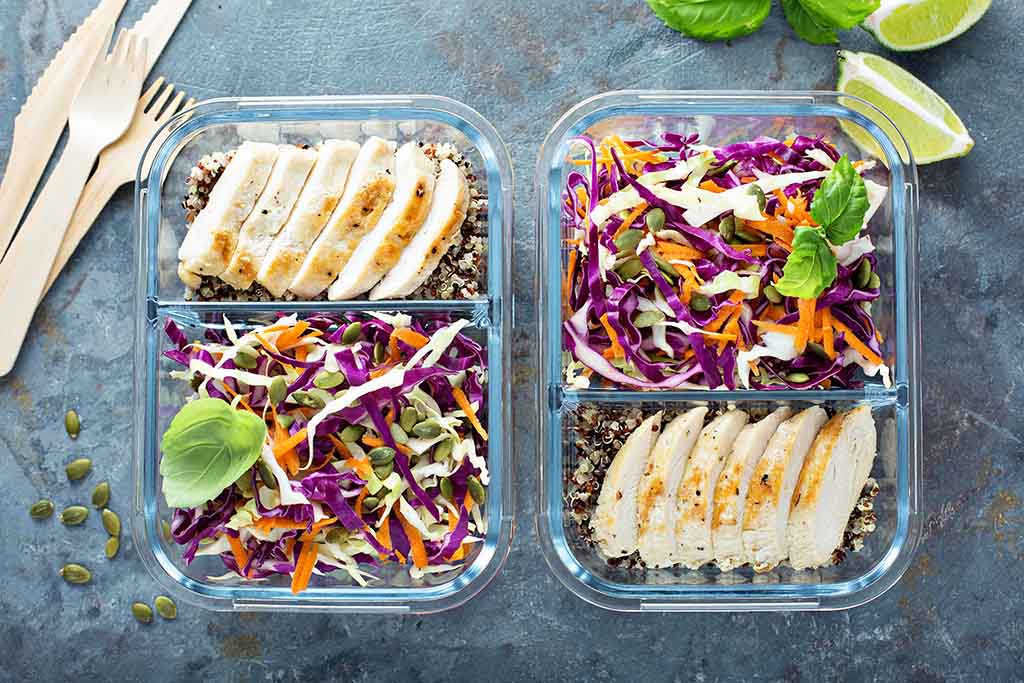

There are fluid restrictions on long-haul flights (maximum of 100ml per container) but there aren't currently food restrictions. However, it's always advisable to contact your airline to double check if you have any doubts.
If you want to eat on your flight, you might prefer to bring your own food and snacks for the flight. You can purchase an insulated bag with ice pack inserts (like this one ). Some great meal and snack options include:



































Grilled chicken pieces



































Slices of cooked beef or lamb



































Tins of tuna or sardines (your neighbours might not love you for this though)



































Salad or cooked vegetables



































100ml container of salad dressing



































Veggie sticks with a small container of chunky roasted pumpkin and macadamia dip



































Pieces of fruit



































Nuts and seeds



































Nut butters in individual portions



































Jerky



































Individual portions of cheese (if tolerated)



































SIBO friendly crackers



































Potato or vegetable chips cooked in suitable oil and seasoned with salt



































A container of my Prosciutto, Egg and Capsicum Muffins or Blueberry Muffins



































Chocolate bark , flavoured chocolates or choc chip granola bars for a sweet treat



































The Elemental Diet - I use the Integrative Therapeutics Physicians Formula (bring the powder and a shaker. You can ask for ice and water to make it into a drink)
You won't be able to take your food into your arrival destination so don't go crazy - just bring as much as you think you can eat so you don't have to throw a lot of food out at the end of the flight.
In case the security screening confiscates your ice packs, always pack a leak-proof zip lock bag says Monica Hardy from our SIBO Bi Phasic Diet Facebook Group . She asks the flight attendants to fill it with ice once she gets on the plane so she can still keep her food cool.
You don't have to eat on a long-haul flight. Instead, you may choose to use the time to fast and just sip water or herbal teas.
Personally, I find having an empty stomach easier on my body than having it full of food. I always bloat on flights, no matter what I do, so the more I avoid food, the easier it is on my system.
I do find that I get very hungry on long-haul flights, so even if you decide to fast, I would recommend you have a back up in case you change your mind. When everyone else is brought their food and the cabin is full of food smells, it can be very difficult to maintain your resolve to keep fasting.
Because I always bloat on long-haul flights, I always wear loose fitting clothes with stretchy waistbands that will allow my belly to grow over the course of the flight. There is nothing worse than being stuck in tight-fitting clothes, in pain from the bloating, and not able to do anything about it.
I also like to layer my clothes. This helps hide the bloating. I take a long scarf, a long cardigan and a jacket. That way I can layer up if I get cold or strip down to a lighter top if the plane is hot. Most of the trips I've done recently are freezing cold, so I'm always glad I've got multiple layers.
I also spray my scarf with perfume or essential oils so that if there are smells on the plane that I don't like, I can bury my nose in my scarf and avoid them.
Finally, pack a spare pair of underwear and clothes. I always plan for the unexpected. If you have an upset tummy and have an accident, you can feel better knowing you can change your clothes. Or, if your luggage goes missing, you at least have one outfit and new underwear to wear.
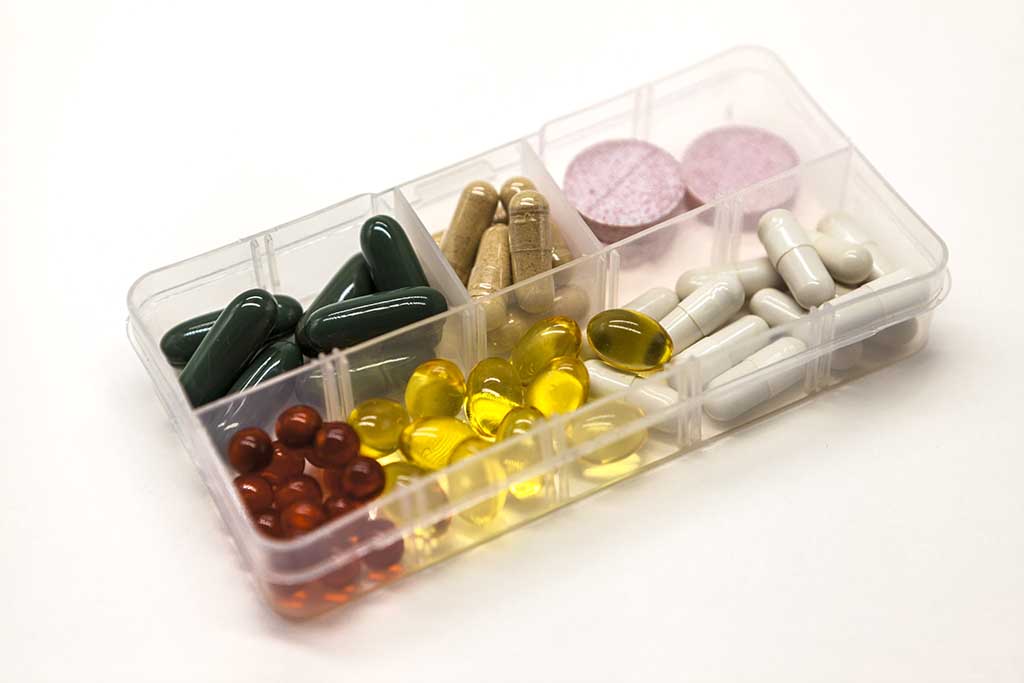

Talk to your Practitioner about your forthcoming trip. They will review your medication and may even suggest some additional supplements to support you. Before I flew to Thailand, I saw my Naturopath and we added in some extra herbs to help prevent potential food poisoning.
Choose where you will carry your medication. I put it in my hand luggage. That way, if my main bag is delayed, I still have my medication with me. Get a small cooler bag for any medication that needs to be kept refrigerated.
Ensure you have enough for the duration of your trip. You don't want to run out in a foreign country, where you might find it hard to get replacements.
During the flight, you may want to take some supplements to help with any symptom you experience. Dr Allison Siebecker has a handout with a range of supplements for each type of symptom . Some common supplements to pack include:



































Activated charcoal



































Iberogast



































Gas X



































Peppermint oil



































Magnesium



































IBGuard



































Electrolyte replacement or oral rehydration



































Imodium
Changing time zones? Get ready for your new time by getting to bed earlier or staying up later in the days leading up to the flight and before you head home. Timeshifter is a handy app that helps you prepare for your new timezone by giving you tips on when to avoid or get things like sunlight, caffeine, sleep and melatonin.
Most international flights come with in-flight entertainment. However, I have been on a handful of flights where the entertainment system has broken. For this reason, I always have a backup plan. I download Netflix movies and tv shows onto my iPad, which I can watch when I'm offline. I have a couple of books available in my Kindle app on my iPhone and have enough podcasts and audiobooks downloaded that I can listen to them for the full duration of the flight if I need to.
If you're an anxious flyer, why not download a meditation app to your phone, so you can do some meditation while you're flying?
Aeroplanes are notoriously germ-ridden places. Everything from faecal matter to Methicillin-resistant Staphylococcus aureus (MRSA) bacteria has been found hiding in the passenger cabin of planes.
Pack anti-bacterial wipes in your carry-on bag and use them to clean your armrest, tray, seat belt clip, toilet door handle and flush.
I also use the Biocidin Throat Spray during the flight. It helps ward off any germs that are spread if people are coughing and spluttering on the plane.
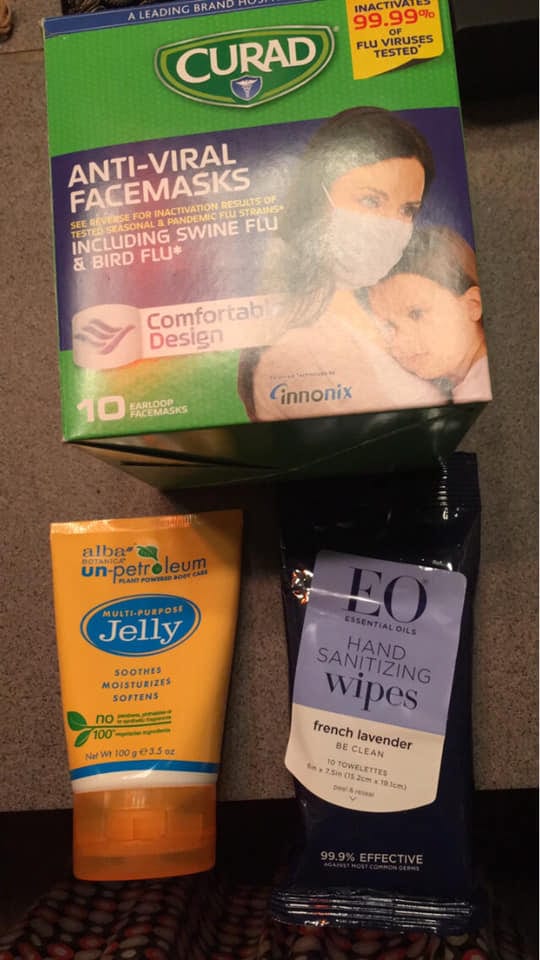

My SIBO Coaching client , Sharon Treadgold packed these items for her recent trip to Australia from the US. The face masks gave her an added sense of security that she wasn't breathing in other peoples' germs.
Of je nu van plan bent om tijdens de vlucht wakker te zijn of te slapen, als je wat comfort van thuis meeneemt, kun je je meer ontspannen voelen. I travel with noise cancelling headphones, my own blanket, a revitalising moisturiser from Ecology Skincare , a neck pillow, eye mask and ear plugs. I also wear flight socks and have a pair of flip flops handy so I can walk into the toilet with shoes on.
Studies hebben aangetoond dat de dekens die je in het vliegtuig ontvangt niet al te hygiënisch zijn, omdat ze niet regelmatig worden schoongemaakt, ondanks dat ze in een nieuwe plastic verpakking zitten. Je kunt je alleen maar voorstellen waar mensen ze voor gebruiken:vuile handen afvegen, neuzen snuiten, luiers verschonen of andere even onaangename bezigheden. It’s not something we want to snuggle up with.
Aeroplane travel is extremely dehydrating. The longer you spend on a plane, the more dehydrated you will become. It is important you are constantly sipping water to keep your body hydrated. Avoid alcohol as this increased the dehydration and can also cause digestive distress.
I take an empty water container through security and then fill it up before I board the flight. I then ask the staff to fill it up with water during the flight.
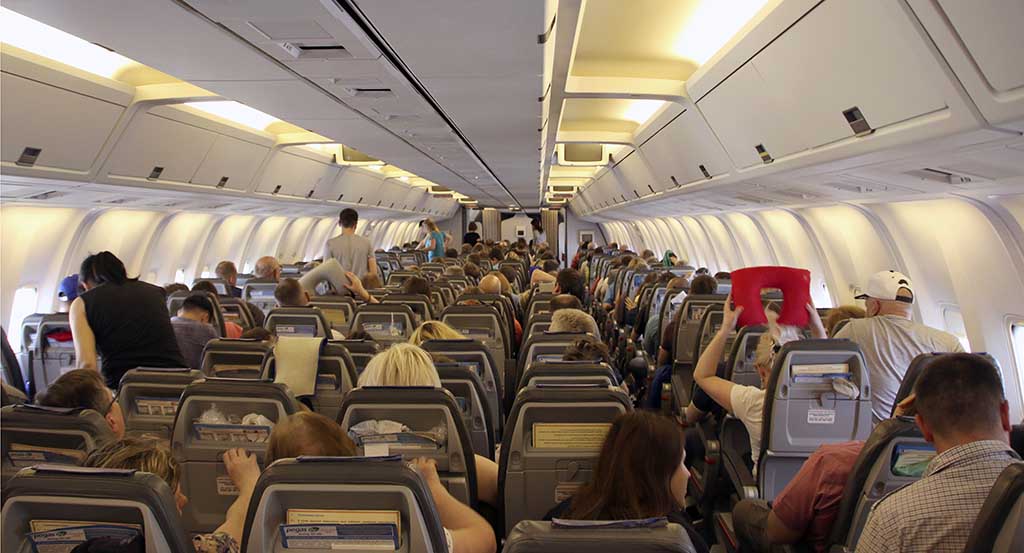

When you are sitting down for many hours at a time, your digestion can slow down and get sluggish. Whenever possible, get up and move your body on the flight. I like to walk up and down the aisles or I will go and stand down the back of the plane and do some simple stretches. If you have a layover, use it as an opportunity to stretch your legs. I walk up and down the terminal, moving constantly until I need to get back on the plane.
On my most recent flight to the US, I departed Melbourne at 11.30am. As soon as I got on the plane, I changed my watch to US Pacific Time and started telling myself that it was 6.30pm. As soon as we had been fed dinner, I told myself it was bedtime and took a melatonin tablet and went to sleep. When I arrived at LAX at 9am, I was relatively refreshed and ready for the day ahead.
The first thing I do when I arrive at my new destination is to go outdoors and get some fresh air and sunlight on my skin. This helps acclimate to my new timezone and environment. Even if I have arrived at a winter destination, I wrap up nice and warm and head out.
If the weather is warm, I like to touch the ground with bare feet. Dave Asprey of Bulletproof fame talks about how earthing helps return the body to a neutral current. I personally find it beneficial and make an effort to touch the ground with bare feet whenever I can.


After many hours crammed into a plane, there is nothing better than moving your body. It helps to get fresh oxygen to all parts of your body, and can also help reset your circadian rhythm to your new timezone. I always pack a sturdy pair of walking shoes and hit the pavement of my new location. It's a great way to check out your new neighbourhood while also exercising. Check out a local yoga or pilates class for some structured exercise or do a walking tour.
You might be off the plane, but it doesn't mean your body isn't still recovering from the impact of long-haul travel. Keeping your food simple will help ease the pressure on your gut. I love nothing more than some steamed or grilled fish and steamed veggies when I first arrive. Also keep your meal sizes small to give your gut a chance to process the food. As tempting as it might be, avoid alcohol as this will contribute to your dehydration and can interrupt your sleep cycle.
I always incorporate intermittent fasting into my travel routine. It helps my gut calm down from the pressure of travelling, and I find I sleep better when I haven't eaten a lot.
You might like to ensure you get at least 12 hours break between dinner and breakfast, or if you're like me, you can skip breakfast entirely and just eat lunch and dinner.


Spend the first few days of your new location focusing on hydration. Your body has been put under enormous pressure on the plane, so be kind to it and drink lots of good quality, filtered water.
Doing all of the above will help re-set your circadian rhythm. If you arrive in the morning, stay awake as long as you can, ideally going to bed at your normal bedtime.
If you must take a nap, keep it short so you don't confuse your body and further disrupt your sleep cycle.
If you are still struggling to sleep, you might like to take a sleeping aid. I use Integrative Therapeutics Cortisol Manager to help re-set my cortisol levels. If this isn't enough support, I will also take some melatonin at bedtime. This will normally put me to sleep within 30 minutes of taking it.
If you wake during the night, try to avoid turning on any electrical devices. The blue light emitted from these devices can disrupt your sleep-wake cycle. Instead, try some meditation, deep breathing or relaxation techniques. If that fails, I will lay in bed and read a book until I get sleepy again.
It is estimated that for every 1 hour of timezone change, it can take 1 day to recover. Be kind to yourself during this recalibration to your new time zone. If sleep isn't coming easily, stressing about it will make it worse. You will get into your new timezone eventually.


It is a privilege to travel and see new parts of the world. Yes, SIBO can be frustrating, but you have control over how you think . If you choose to approach travel with fear, it's highly likely your trip will be extremely stressful. Instead, if you approach your trip with interest and intrigue and allow for situations to happen that are outside of your control, you will enjoy your trip much more.
I love the uncertainty of travel. I love meeting new people, tasting new food, learning new languages, smelling new smells, seeing new cities and landscapes, and even when things go wrong, I find a way to laugh about it.
Before you go, brainstorm a wide range of possible scenarios and think about how you will handle those situations. The more prepared you are, the easier they will be to cope with.
Do you have your own fool-proof travel hacks? I would love to hear them. Simply put them in the comments below.
Pin945 Shares Spijsverteringsstoornissen:verrassende redenen waarom je gasachtig bent
Hoeveel gas is te veel? Gas is normaal. Het maakt deel uit van je spijsvertering en iedereen heeft het. De meeste mensen geven vijf tot vijftien keer per dag gas. Maar als je het gevoel hebt dat je
Spijsverteringsstoornissen:verrassende redenen waarom je gasachtig bent
Hoeveel gas is te veel? Gas is normaal. Het maakt deel uit van je spijsvertering en iedereen heeft het. De meeste mensen geven vijf tot vijftien keer per dag gas. Maar als je het gevoel hebt dat je
 Darmkanker (darmkanker)
Darmkanker (darmkanker) feiten Darmkanker is de derde belangrijkste oorzaak van kanker in de VS Colorectale kanker is een kwaadaardige tumor die ontstaat uit de binnenwand van de dikke darm (colon)
Darmkanker (darmkanker)
Darmkanker (darmkanker) feiten Darmkanker is de derde belangrijkste oorzaak van kanker in de VS Colorectale kanker is een kwaadaardige tumor die ontstaat uit de binnenwand van de dikke darm (colon)
 Welke methode is het beste om nierstenen te verwijderen?
Retrograde intrarenale chirurgie (RIRS) is de beste procedure voor het verwijderen van nierstenen en bestaat uit de volgende stappen. De behandeling van nierstenen hangt af van verschillende factoren
Welke methode is het beste om nierstenen te verwijderen?
Retrograde intrarenale chirurgie (RIRS) is de beste procedure voor het verwijderen van nierstenen en bestaat uit de volgende stappen. De behandeling van nierstenen hangt af van verschillende factoren